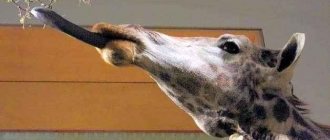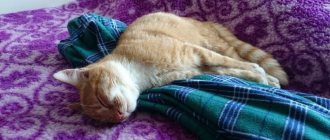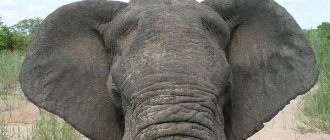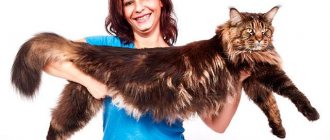Relatives of domestic cats are quite numerous: the existing classification notes the existence of 41 species of representatives of this family. Most of these animals are similar to each other, distinguished by their beauty and noble habits, although some wild relatives of domestic purrs stand out from the general crowd. Large and small cats, among which there are rare and endangered animals, are predators. At the same time, any of the predatory animals on our planet falls into the category of canines or cats. The latter, in addition to large and small cats, include the families of hyenas, civets, mongooses, Asian linsangs, and palm civets.
History of origin and habitat
The first relatives of modern cats formed at the initial stage of the current geological era (Cenozoic). More than 50 million years have passed since then. Scientists say that the familiar appearance of wild representatives of the cat family was formed after the end of the glaciation period. These predators turned out to be one of the lucky few who managed to survive the increase in average annual temperatures. For most other animals with dense, thick fur, the new warm climate of the Earth turned out to be too hot.
The appearance of individual specimens (manul cat) has remained the same since then, other animals have changed greatly in the process of evolution, but have retained the distinctive features of the cat family.
The ancestor of modern predators, miacids, was small in size and had a long tail. In the Oligocene era (about 30 million years ago), these carnivorous animals took a dominant position on the planet.
The extinct predator Proailurus, which most scientists consider the ancestor of small and large cats, spread across the planet 25 million years before the present. This 9-kilogram animal is very similar to the current inhabitant of the island. Madagascar - fossu. About 18.5 million years ago, Proailurus evolved into Pseudelurus. These animals, which first appeared in Eurasia 7 million years ago, entered North America. Of the modern mammals, Pseudalurus most closely resembles African linsangs.
Pseudaelurus was the ancestor of three types of cats: small, large, saber-toothed. Huge saber-toothed mahairods arose 15 million years ago, died out 2 million years ago, leaving no descendants.
Nowadays, predatory relatives of domestic cats are widespread throughout the planet, primarily in warm climate zones. You can’t meet these elegant, flexible hunters only in the snowy expanses of Antarctica and Greenland, Australia and Madagascar. In temperate climates, wild cats are not as widely represented as near the equator or in the tropics. The taiga zone provides shelter only for certain species: lynx, puma, tiger, wild forest cat. But domesticated fluffies amaze with the variety of breeds and are found in all parts of the globe.
The first domestic purrs appeared 7-10 thousand years ago. The cats of Ancient Egypt, deified by man, are well known. Today, many representatives of wild cats have to fight for existence. Modern people have realized the need to preserve the diversity of the Earth's fauna by adopting the necessary international laws to protect flora and fauna.
Natural enemies of forest cats
Photo: Siberian forest cat
Forest cats are very dexterous and agile creatures. It is very difficult for other predators to hit them. Thanks to their ability to quickly jump from branch to branch (the length of the jump can be 3 meters), move through thickets and swim, felines easily hide from potential rivals. At the same time, the animals have enough enemies.
The main ones are:
- Foxes (dangerous for almost all species of forest cats, this is due to the expanded habitat of foxes);
- Jackals (they pose a threat to felines living in Southeast Europe and Asia);
- Martens (they hunt forest cats in the mixed forests of Asia and Europe);
- Lynx (such animals threaten mainly cats living in the northern hemisphere).
The main predator of forest cats (no matter how strange it may sound) are martens. Despite their significantly smaller size, they quickly infect young cats, contenting themselves with their meat.
Interesting fact: Despite the fact that jackals are considered enemies of forest cats, they themselves are afraid of these animals. When meeting a wild cat, the jackal will prefer to abandon the carrion it has caught, returning to eating it only after the animal has left.
Most cats become prey due to old age, illness or injury that limits normal movement. In standard situations, it is extremely difficult to catch up with the beast.
Characteristic
The cat family (Felidae) includes mammalian predators with common characteristic features: lifestyle, type of nutrition and reproduction, morphology, hunting habits.
Morphology
The sizes of representatives of the cat family range from 30 cm to 4 m, body weight - from 1 kg to 300 kg. Males differ from females in their greater mass, impressive dimensions and additional external features (lion's mane). The largest in the family are lions and tigers, the smallest are black-footed and spotted cats.
Paw structure: 5 toes on the front paws, 4 toes on the hind feet. Sharp claws tend to hide under the paw pads. Cheetahs, as well as Sumatrans, do not possess the latter quality.
Number of teeth: 28-30. This is much less than other known predators. This corresponds to the specific structure of the head: a rounded skull with a short muzzle. With a small number of teeth, effectiveness is achieved by a strong bite. The long, cone-shaped fangs easily tear through the flesh of prey with minimal jaw force. The teeth located behind the cheeks are used to tear pieces of meat from the victim’s body.
The rough tongue is used to lick the remaining meat from the bones of prey and to keep the skin clean.
Long tail, sometimes with a tassel at the end.
The coat is most often short and thick, although differences in density and length are possible depending on the climatic zone of the habitat.
The color palette of the skin varies from brown to gray. Types of colors: plain, spotted, patterned, striped. There are entirely black individuals or (much less often) albinos. The animal's color may change as it grows. For example, lion or puma cubs are covered in spots, while adults have a solid color. The back and outer surface of the limbs are darker than other areas. The animal's muzzle, forehead and tail usually have markings in the form of spots or lines.
Lifestyle
All cats are characterized by excellent functioning of the organs of vision, an expanded range of perception of sounds, up to ultrasonic frequencies. The sense of smell is also good, but in terms of sensitivity it lags slightly behind the two primary indicators.
These animals usually show maximum activity in the dark. Night time is for hunting, day time is for rest.
Lifestyle – solitary or gregarious. At the head of the pack (pride) is a strong aggressive male, who directs the entire life of the community.
A distinctive feature is to make specific sounds (purring). Small cats can purr while inhaling and exhaling, but large cats can only purr while exhaling. Other sounds: roar, hiss, scream, meow. Loud roars are the privilege of large predators. The structure of the hyoid bone does not allow small cats to roar.
Members of the cat family owe their silent movement and the ability to make quick, easy jumps to their toe-based gait.
The process of tracking the victim is simplified thanks to an additional mirror layer on the iris of the eye. This feature allows furry hunters to examine objects at night. In low light, a cat sees 7 times better than a human.
The vertical modification of the pupil provides the predator with a wide view, and the width of the slit is adjusted depending on the light level.
Equipped with muscles, the ears can easily change their geometry, creating a three-dimensional picture of the surrounding world thanks to signals coming from different directions.
Vibrissae, which are commonly called whiskers, are an organ of the “sixth sense” that sends signals to the brain perceived from the environment. Sensors on the paw pads provide information about humidity, atmospheric pressure, and temperature.
An additional olfactory receptor is designed to recognize individuals of the opposite sex.
With rare exceptions, relatives of cats move freely on vertical surfaces and climb to great heights.
The internal etiquette of relationships requires caution and the exchange of signals indicating mood. Unbridled aggression is not the norm of communication.
Like other predators, relatives of cats mark their habitat by secreting a liquid with a specific odor and leaving marks with the help of their claws.
Reproduction
Representatives of cats are distinguished by polygamy. The head of the pack mates with all the females of the pride, so most members of the pack are blood relatives. A wide variety of genes and little competition between males ensure the survival of the young. The season of readiness for mating in females lasts 1-20 days and resumes until fertilization occurs. During the period of estrus, the female calls her partner with special signals and marks the places near the mating area with an odorous liquid.
Competition between male specimens for the attention of a female is expressed in fights, signs of attention, and poses expressing submissiveness (bowed head). The duration of coitus is less than a minute, the act is repeated many times until the girlfriend becomes pregnant. At the end of estrus, the male sets out in search of a new passion.
For animals living in cold zones, the mating season coincides with the warm season.
Small pussies give birth 2-3 times a year, large ones - once every 18 months. Newborn babies are not adapted to independent living and feeding; their visual organs open some time after birth. The mother usually raises the offspring, but for some species nature made an exception and allowed the fathers to also take care of the children. The interval between births depends on several parameters: the rate at which the babies grow up, their size, and the amount of food available in the region where they live. If the litter dies, the female is again ready for mating after 10-20 days.
The number of babies in a litter ranges from 2-4 to 8-10. Small females are ready for pregnancy by the end of the first year of life, carry the cubs for 2 months and keep the offspring breastfed for a month. Large predators learn the joy of motherhood at the age of 3-4 years, carry babies in their wombs for 3 months, and teach their children to solid food 3 months after birth.
Life span is from 10 to 30 years. Minor kittens are exposed to many dangers: death from predatory animals, developmental defects, mother's refusal to feed, cannibalism.
Nutrition
Predatory cats living in the wild feed almost exclusively on meat obtained by hunting. Carrion is rarely of interest to these animals. The diet includes a small amount of herbs to cleanse the stomach of poorly digestible foods. Residents of hot countries add fruit and vegetable desserts to the menu to restore water balance in the body.
Large animals prefer to feed on ungulates, while small animals prefer to eat rodents, birds, and sometimes fish and amphibians.
Unlike cat cubs, other animals are not dangerous to adult predators. Some animals suffer from infection with ecto- and endoparasites (worms, lice, ticks, etc.)
Types of wild cats
Conventionally, all wild cats can be divided into small and large. Each of these groups has its own characteristics. Thus, in most large representatives of the family the basis of the tongue is cartilage, and in small ones it is bone, so the former emit a roar when exhaling, and the latter produce a rumbling sound. In addition, large cats do not have hair between the upper lip and nose, while small cats do.
Small
Another distinctive feature of small cats is that they prefer to feast on prey while sitting or standing. When resting, these predators tuck their paws under themselves and “hug” their bodies with their long tails.
Table of species of small cats
| Animal | Subspecies | Appearance | Weight, kg | Length, cm | Peculiarities | Nutrition | Habitat | Habitats | Security |
| Cheetah |
| 43 | 100–150 |
|
|
|
| Listed in the Red Book. In Asia, cheetahs have practically disappeared, and their number in Africa in 1971 was 8–25 thousand individuals. | |
| Caracal |
| 11–13 | 65–82 | Hunts during the day in winter and spring | Small mammals |
|
| Listed in the Red Book of Kazakhstan. People breed it in nurseries in the hope of preserving the population. | |
| Catopumas | Kalimantan |
| 2,3–4,5 | 85 | Carefully hidden from prying eyes and is still a mystery to scientists | Small mammals |
| Indonesia | Listed in the Red Book. Deforestation in Borneo makes their species quite rare. |
| Asian golden or Temminka |
| 8–11 | 75–105 |
|
|
|
| Cats are listed in the Red Book; there are about 10 thousand of them. They are difficult to tame, so they are suitable for aviary keeping. | |
| Cats | Gobi gray |
| 5 | 97–119 |
| Small mammals |
|
| Listed in the Red Book. |
| jungle cat |
| 5–15 | 100 | Easily catches birds in flight, making beautiful jumps. | Small mammals | Wetlands with bushes |
| Listed in the Red Book of Russia | |
| Manul or palass cat |
| 3,5–4 | 52–65 |
| Small mammals |
|
| Listed in the Red Book | |
| Barkhannaya |
| 2,8 | 60–90 | One of the smallest representatives of wild purrs, leading a secretive lifestyle | Small mammals | Deserts |
| Listed in Appendix II of the CITES Convention | |
| Blackfoot |
| 1,5–2,5 | 56 | The cat has an aggressive character; it is difficult for her to live in captivity, especially if there is another pet living in the house. The cat is jealous and guards its territory, and it is better to tame it at the age of a kitten. | Small mammals |
|
| Listed in the Red Book | |
| Golden |
| 11–14 | 90–120 | Incredibly flexible, which allows you to silently approach prey |
| Tropics |
| African forests are rapidly being destroyed, and Cameroonian pygmies use the fur and tails of golden cats for ritual purposes. The population numbers about 10 thousand adult individuals. In all countries, hunting these animals is prohibited or limited, which does not prevent poachers from exterminating the genus. | |
| European forest |
| 6–8 | 50–90 | No | Small mammals | Mixed and deciduous forests of mountains and plains |
| There are no special protection measures to preserve the animal. | |
| Steppe or African |
| 3–8 | 70 | No |
| Deserts and mountains |
| The main threat to the species is hybridization with local domesticated cats, extermination by farmers after the animals attacked poultry. The animal is not listed in the Red Book, but this species is preserved in zoos. | |
| Brindle | Pampas, grass or bell |
| 3–9 | 76 | There is evidence that in nature pussies are aggressive and cannot be tamed | Small mammals | grassy plains |
| Since 1980, the cat has been protected |
| Geoffroy |
| 4–5 | 73–77 |
|
| Pampas and wooded areas |
| Protected by the Washington Convention for the Protection of Nature | |
| Chilean or Kodkod | The color is brownish-gray, with dark stripes and spots on the tail and back. The ears are black, with white spots at the back. | 1,8–2,7 | 55–76 |
| Small mammals | Coniferous and mixed forests |
| Is under state protection, listed in the Red Book | |
| Andean |
| 4–7 | 70 | Carefully hidden from people, poorly studied | Vizcachas are rodents of the chinchilla family. | Mountains |
| Together with the tiger, snow leopard and Kalimantan cat, it is endangered. Listed in the Red Book. | |
| Ocelot | The golden skin is covered with many dark spots of different sizes and shapes. | 8–20 | 68–100 | Secretive |
| Tropics or dense bushes |
| Is under state protection | |
| Oncilla or tiger |
| 3 | 50 | Despite its small size, oncilla is quite bloodthirsty and aggressive. It is typical for her to engage in fights with larger animals, and often win. |
| Subtropics |
| Cats are hunted for their beautiful fur and are disappearing due to deforestation. These animals are listed on Appendix I of CITES. | |
| Longtail or margay |
| 3 | 90–100 | No | Small mammals | Plains and forests | South America | It is under protection, its catching is prohibited | |
| Serval |
| 12 | 83 | There are white stripes on the back of the animal's ears. They resemble eyes and are visible above the surface of the grass: thanks to them, kittens do not lose sight of their mother during the hunt. The animal loves to watch and wait, which makes it one of the best hunters. The animal lies in the grass, and presses the caught prey to the ground with its body, then, without allowing it to come to its senses, it bites into the throat. Thanks to this tactic, every second serval prey is successfully caught. Before eating, the animal plays with the prey for several minutes, and then begins to greedily eat it. Servals live not only in the wild: they are kept in nurseries and at home. With proper upbringing, owners get smart and loyal pets. |
| Savannah |
| The northern subspecies is listed in the Red Book | |
| Lynx | Canadian |
| 8–14 | 80–117 | It is more common for animals to eat prey in trees. In times of hunger, these animals do not disdain carrion. During the mating period, the male courts several females located next to him at once. |
|
|
| The animal is included in Appendix II of the CITES Convention. Lynx of this species can be kept in captivity. Their cubs quickly become tamed. |
| Ordinary |
| 20 | 130 | The largest pussy of this kind. Having noticed the prey, the lynx begins to pursue, reducing the distance to it. When there are 15 meters left to the intended victim, the predator overtakes it in several jumps. It digs its claws into the body of its prey and tears at its neck. | Small mammals | Dense forests |
| Listed in the Red Book of the Moscow Region and Ukraine | |
| Pyrenean | The color resembles a leopard - characteristic dark spots are clearly visible on the fairly light skin | 20 | up to 100 | No |
| Mountains | Mountains of Spain | It is a rare animal and is protected by natural organizations. The animals are bred in captivity in Spain and then released into the wild. | |
| Redhead |
| 6–14 | up to 60 | The smallest of all lynxes. She likes to appear on the outskirts of villages and small towns in anticipation of domestic prey. |
|
| North America | The red lynx is under state protection. Its destruction is prohibited by law. | |
| Marble |
| 4–8 | 106–104 | This predator usually lives in trees |
| Jungle |
| Due to deforestation of the jungle, the species is on the verge of extinction. It is listed in Appendix I of CITES. | |
| Asian | Amur or Far Eastern forest | The tone of the coat is grayish-brown or grayish-yellow, the skin has random spots of dark red color | 4–6 | 70–90 | No | Small mammals |
|
| Listed in the Red Book of Primorsky Krai |
| Iriomotskaya | The color is dark brown, with black spots arranged in a horizontal row. | 3–7 | 35–65 | No | Small mammals | Subtropics | Iriomoto Island | Protected by law and supervised by the Japanese government | |
| Sumatran |
| until 3 | 57 | The predator's muzzle resembles a loris monkey. Usually hunts along river banks. In case of danger, he prefers to leave the battlefield. During mating, males call cats with a sound resembling vibration. To get prey, the cat can plunge its head into the water. |
|
| Indonesia | In some zoos this predator has taken root and even given birth to offspring. Here, they are primarily concerned with the conservation and study of this species of animal. They are listed in the Red Book and are under state protection. | |
| Rusty or spotted red |
| up to 1.6 | 35–48 | The smallest representative of Asian cats | Small mammals |
|
| Listed in the Red Book and the CITES Convention. In zoos, animals rarely take root, but in Berlin, kitties even managed to give birth to offspring. | |
| Viverrid, fisherman |
| 10–15 | up to 100 | They wander through the shallow water and catch fish with their paws. Cats have membranes on their paws that allow them to swim long distances. | Small mammals | Jungle and mangrove swamps |
| Is under state protection | |
| Leopard print | The coat color is silver-gray or yellow, with black rosettes or spots, and the underside of the head and chest is white. | 4,5–15 | 65 |
| Small mammals |
|
| They are listed in the CITES appendix and are under state protection, however, according to scientists, today there is no talk of a threat of their extinction. | |
| Cougars | Puma |
| 62 | 240 |
|
|
| America | It is listed in Appendix I CITIES, and the Florida cougar is listed in the Red Book. However, these animals reproduce quite quickly, so we are not talking about their extinction. |
| Jaguarundi |
| 6–8 | 55–67 |
| Agouti | Wetlands, forest edges |
| Protected, but quickly exterminated due to the destruction of its natural habitat | |
Photo gallery of small cats
The cheetah's long, strong tail acts as a balancer when hunting.
Caracal is a rare animal listed in the Red Book of Kazakhstan
The Kalimantan cat feeds on birds, carrion and small mammals. The Temminka cat has a white stripe with a black border between its eyes.
The Gobi gray cat is the only cat species that lives only in China. The number of Pallas' cats is very low, the animals are listed in the Red Book
The number of dune cats is approximately 50 thousand adults
Black-footed cats are on the verge of extinction, as they often fall into forest traps, and deforestation occurs in their habitat
Typically, a female European forest cat gives birth to 3–5 kittens.
The steppe cat is not listed in the Red Book; its species in captivity is preserved in zoos
Since 1980, the Pampas cat has been protected
The Geoffrey cat population is protected by the Washington Convention
The number of Chilean cats is 10,000 individuals. The Andean cat is listed in the Red Book and is endangered
The ocelot has a beautiful color - there are many dark spots on its golden skin
Despite its small size, the oncilla is aggressive and bloodthirsty; it often attacks animals larger than itself. Margay can imitate the cries of monkeys
Servals live in the wild and are kept in nurseries
Canada lynxes are included in Appendix II of the CITES Convention
The common lynx is listed in the Red Book of the Moscow Region and Ukraine
To preserve the population, the Iberian lynx is bred in captivity in Spain. The marbled cat is protected and is listed in Appendix I of CITES
The Amur forest cat is included in the Red Book of the Primorsky Territory
The Iriomote cat is under the protection of the Japanese government
Sumatran cats are listed in the Kars Book
The Berlin Zoo succeeded in breeding rusty cats
Hunting for fishing cats is punishable by law in all countries of the world
The Asian leopard cat is listed in the CITES appendix, but is not currently considered to be endangered
Cougars reproduce quickly, so they are unlikely to face extinction
Jaguarundi are easily tamed at a young age, so they can be bred in nature reserves and zoos
The cheetah never eats carrion. When he is full, he leaves his prey for jackals and birds.
Large
There are four genera of cats, which include 36 different species, six of which are considered big cats. Big cats are the lion, tiger, leopard, jaguar, snow leopard and clouded leopard.
Chart of characteristics of big wild cats
| Name | Length, cm | Weight, kg | Where does it live? | Peculiarities | Appearance | Security | Habitats | Nutrition |
| Clouded leopard | 70–110 | 15–25 |
| This predator kills the caught victim with one blow of its paw. The predator likes to move along branches, being high above the ground, and even holding prey in its teeth. The animal tries to stay away from human settlements. The clouded leopard has an ossified hyoid bone, so it does not growl like other large wild cats, but only purrs. |
| Due to the decline in the size of this population, humans had to intervene in the process of preserving the animal, for which nature reserves are used. It is on the verge of extinction and is listed in the Red Book and the CITES appendix. | Jungle |
|
| Kalimantan clouded leopard | 60–110 | 15–30 |
| After attacking the victim, he removes his limbs and drags him to a safe place. This pussy can be active during the day. |
| Breeding in captivity often does not lead to positive results due to animal aggression, which sometimes causes the death of the female. The animal is listed in the Red Book. |
|
|
| a lion | 160–250 | 150–240 |
| It is considered the only cat that has a mane, which is characteristic only of males. They prefer to hunt in groups, but a specific prey is killed by one predator. The beast tends to use different techniques. Often these animals surround the herd. The dominant lion shares the prey only with the young animals, which they reluctantly allow to the “meal”. They eat only warm meat and leave the cold meat. Attacks from a distance of at least 30 meters. The lioness carefully creeps up on the prey, and if the intended victim pays attention to the surveillance, then the huntress freezes, then begins to move again. During the attack, the female bites the victim in the neck. It is the lioness who brings the bulk of the prey, since lions rarely hunt due to their large size. Despite this, they are the first to approach food. During the “meal” they behave aggressively. Leos tend to live in groups (prides). They include one dominant lion, several females and cubs. The main lion deals with the “kids”. When the cubs grow up, the mature males must leave the pride, and the females can stay or leave. Young males do not live long alone. They are inexperienced, which is why they may suffer in the first fight with other lions for the opportunity to own a pride. Males who have lived alone for a couple of years and gained strength may well conquer the pride. They do not have the right to return to their “father’s house,” since in this case the father himself will kill them. It turns out that the new generation produces the strongest lion. It happens that a male simply “gets acquainted” with a female, after which the resulting pair creates their own pride. If necessary, lions stand up for their pride and cubs. After such fights, the entire pride “sings” a song warning that it is dangerous to approach it. At one month, the cubs begin to growl, and until this moment the mother does not show them to anyone. Leo can be quite strict with his offspring. |
| The African lion is listed in the Red Book as a rare endangered species. | Lowland savannas |
|
| Tiger | up to 350 | more than 300 |
| The largest and most formidable predator of all wild cats. When hungry, he is able to eat everything that comes his way. It happened that these animals even attacked leopards, crocodiles and pythons. Sometimes soil and tree bark become their food. If a tiger gets hungry, it can even eat its own kind. There are predators who are not averse to feasting on humans. During an attack, the tiger does not growl. Sometimes he hunts during the day. Tigers love to swim, especially Bengal tigers that live in the tropics. The predator wanders from place to place, and hunts alone (with a female during the mating period - no more than a week). Jumps horizontally at 8–10 meters. There are 8 types of tigers in total:
The Bali and Caspian subspecies are completely destroyed. The father does not take part in raising the “kids”, but protects the territory. | The animal's skin is orange, yellowish or white, with black stripes. | The Amur tiger is listed in the Red Book, and all other subspecies are under state protection. | Forests and marsh plains with tall grass |
|
| Leopard | 125–165 | 23–37 |
| It happens that black individuals are born with cubs whose fur is colored in the usual color. Without a single sound he creeps up to the victim or slams his paw in the dark in the hope that the antelope will run towards him in panic, where he will overtake it. A predator left to its own devices may die of starvation. |
| The Far Eastern leopard is listed in Appendix I of CITES and the Red Book; its remaining species are under state protection. | Asian tropics | Ungulates |
| Jaguar | 112–185 | 60–120 | Brazil | Leads a secretive lifestyle. Swims well, but cannot growl. Marks territory, leaving claw scratches on logs and tree trunks. Rarely attacks humans. | The color is yellowish, with rosette spots all over the body. | Listed in the International Red Book | Brazilian tropics |
|
| Snow Leopard | 140 | 100 |
| The most ferocious representative of wild cats. Hunts at dusk and dawn. Uses stones when hunting. He jumps on top of the victim and kills him. In summer, autumn and winter, animals can be seen hunting in families - with a female and her cubs. The snow leopard can attack animals three times its size. Thus, cases have been recorded when a predator successfully hunted a bear. Doesn't roar, but purrs or meows deeply. |
| Now the number of snow leopards has increased and amounts to 3,500–7,500 individuals, while in the 1960s there were one thousand animals. About 2 thousand animals are kept in zoos around the world, where they successfully breed. The animal is included in the Red Book of Russia and the world. Now on the territory of Russia there are very few of these animals in general - no more than 70 individuals. | Highlands |
In summer, it adds green parts of plants and grass to the meat diet. |
Photo gallery of big wild cats
The clouded leopard is on the verge of extinction and is listed in the Red Book
The Kalimantan clouded leopard can be active during the day
The African lion is listed in the Red Book, as it is considered a rare endangered species
The Amur tiger is listed in the Red Book, and other subspecies are protected by the state
Black Panther - dark-colored leopard The leopard is under state protection
A jaguar marks its territory by leaving claw scratches on tree trunks.
Currently, the number of snow leopards has increased from 1 thousand to 3.5–7.5 thousand individuals
Genetic classification
Genetic analysis has added new possibilities to the traditional classification based on morphological characteristics, making it possible to rank cats into 8 groups:
- Lions, Tigers and Clouded Leopards, united under the name Panthers.
- A combination of Katopum and Marble cats called Kalimantan cats.
- Caracals.
- Ocelots (8 South American species).
- Lynxes.
- Cougars and Cheetahs under the name Puma.
- Asian species + Pallas's cat are included in the Bengal group.
- Homemade.
Fifth place – Puma
Puma
Other names for puma are mountain lion, cougar, panther. The puma belongs to the genus Puma. Lives in North and South America. Lives in bushes, swamps and forests. Mountain lions are solitary and territorial animals, with ranges ranging from 250 sq. km up to 950 sq. km. The puma has yellow-brown fur, straight ears, and a long tail. The animal is born with spots that disappear as they grow.
Males weigh on average from 50 to 100 kg, females - 30-65 kg . Pumas have large, strong paws and proportionately the largest hind paws in the cat family. This physique helps to jump long distances (4-12 meters) and run fast (60-80 km/h).
The puma does not roar, it makes sounds of hissing, growling, whistling, screaming. Mountain lions are active at dusk, at night, and at dawn; These are predators that eat prey of various sizes - from insects, rodents to medium and large ungulates (especially deer).
The total mountain lion population is estimated to be less than 50,000. The average lifespan in the wild is 8-13 years, in a zoo it is about 20 years.
Bengal tiger
The royal representative of the panther genus, the Bengal tiger, lives in India, Nepal, Bangladesh, Pakistan and China. In Russia its population is 5 individuals. The predatory mammal is one of the largest cats in the world. The height of the tropical forest resident reaches 115 cm, weight - 275 kg. A terrifying roar can be heard at a distance of 3 km. The deadly fangs grow up to 10 cm. The record weight of a male killed in an Indian forest in 1967 was 388.7 kg.
Among the Bengal tigers there are amazing creatures whose snow-white fur is covered with brown stripes. All white individuals have one ancestor - the male Mohan, who was born in 1951 as a result of a gene mutation.
irbis-mihail_semenov.jpg
Snow leopard.
Photo: Mikhail Semenov In 2010, the Russian Geographical Society supported the grant project “In the Footsteps of the Snow Leopard.” Its goal is to study the state of the snow leopard population, its numbers and age-sex structure, as well as key habitats. These data will help solve the problem of optimizing the territorial protection of this species, as well as the ecosystems of Southern Siberia as a whole. In 2012, the project “In the Footsteps of the Snow Leopard” grew into a full-scale project “Wild Cats of Southern Siberia” to study and preserve rare species of cats in the south of Siberia - snow leopard, manula and lynx.
Manul
The Pallas's cat is a predatory mammal of the cat family, one of the least studied wild cats in the world. Pallas's cat is widespread in Central and Middle Asia, from Southern Transcaucasia and Western Iran to Transbaikalia, Mongolia and Northwestern China. Within Russia, Pallas's cat is found in the Chita region, Buryatia, Tuva and Altai. Included in the Red Books of the Russian Federation, the Trans-Baikal Territory, as well as the republics of Tyva and Buryatia. Manuls can be seen in the Sayano-Shushensky, Khakassky, Daursky nature reserves. The exact number of the species is unknown due to the secretive behavior of the Pallas's cat and the patchy nature of its distribution. Pallas's cat is listed in the Red Book of the Russian Federation, the IUCN Red List and Appendix II of the CITES Convention.
a lion
There are no two absolutely identical lions on the planet. The “facial” features of each animal are unique and belong to only one individual. The body length of the royal individuals of the fauna world is 1.7–2.5 m, height – up to 1.2 m, weight – 160–280 kg. The largest specimen lived in South Africa and weighed 313 kg.
In hunting, the lion is helped by 7-centimeter claws and vision, the acuity of which is 6 times greater than that of a human. Running is not a predator's strong point. At short distances, the giant cat accelerates to 60 km/h, but after 200 m it gets tired and stops pursuing its prey. Lack of stamina forces the animal to get as close as possible to the victim and in a swift jump deliver a fatal blow. Lionesses are lighter and faster than males, and therefore more successful in hunting.
manul-evgeniy-mazurin.jpg
Manul. Photo: Evgeny Mazurin
Lynx
Lynx is a genus of predatory mammals of the cat family, closest to the genus of cats. It lives in Russia, Scandinavia, Finland, some areas of Poland and the Czech Republic, as well as in Spain. In Russia it is found in dense, overmature coniferous forests from the western borders up to Kamchatka and Sakhalin. The lynx is included in Appendix I of the Convention on International Trade in Endangered Species of Wild Fauna and Flora (CITES) and in the list of endangered animals of the international Berne Convention. This rare, endangered species is also present in the Red Data Books of Belarus, Kazakhstan and 17 constituent entities of the Russian Federation.
Liger
The result of the love between the tigress Isla and the lion Arthur, who shared a common enclosure at the American theme park Jungle Island, became a kitten, which was later destined to top the ranking of the largest cats on the planet. Having reached maturity, the liger Hercules surpassed his parents in size. His height is 186 cm, weight - 410 kg. Standing on his hind legs, the giant reaches the roof of a double-decker bus. The gaping mouth is as wide as the shoulder girdle of an adult man.
Hercules is not the only representative of the hybrid genus. In 1973, the Guinness Book of Records added a record of a giant weighing 798 kg from a South African nature park. In 2004, a female was born at the Novosibirsk Zoo - the result of crossing an African lion and a Bengal tigress. It is impossible to meet a liger in natural conditions - tigers and lions have different habitats.
Related Posts
Top 10 Fastest Animals in the World
Top 10 rarest cat breeds
Top 10 Most Expensive Cat Breeds in the World
manul2-evgeniy_mazurin.jpg
Manul. Photo: Evgeny Mazurin
Interesting Facts
- The Pallas cat looks like a typical small cat, similar in size to its domesticated relatives. The body length of males reaches 65 cm, weight can reach up to 6 kg.
- The animal does not know how to run fast, so it escapes from enemies by resorting to hiding, in which protective coloring helps it, or by hiding in a shelter - a narrow niche, hole, on a rock, on a tree.
- Pallas's cat feeds mainly on pikas and rodents: gerbils, voles, ground squirrels, hamsters, as well as partridges and chukars. Sometimes it catches young marmots, tolai hares, and small birds. The Pallas's cat obtains food mainly from ambush, lying in wait for a long time for the victim at the entrance to the hole. The main trump cards of predators are long, motionless hiding and lightning-fast throw.
- It is difficult for Pallas' cats to live in places with high snow cover. For a cat, even 20 cm of snow is already a disaster.
- The Pallas cat received its second name - the Pallas cat - in honor of the Russian and German naturalist Peter Simon Pallas, who first gave a scientific description of this species on the coast of the Caspian Sea in the 18th century.
irbis-pixabaycom.jpg
Snow leopard. Photo from pixabay.com
Interesting Facts
- A male snow leopard reaches a length of 125 cm and weighs up to 45 kg.
- Snow leopards make dens in caves or rock crevices. Each snow leopard lives within the boundaries of a strictly defined individual territory. However, it does not aggressively defend its territory from other members of its species.
- The basis of the snow leopard's diet is mountain goats, rams, roe deer, wild boars, marmots, hares and snowcocks. Snow leopards consume plant food - green parts of plants and grass - in addition to their meat diet only in the summer.
- The snow leopard is able to cope with prey three times its mass. Usually he hunts alone, crawling up to the animal from behind shelters. When there are several tens of meters left to the potential prey, the snow leopard jumps out of its cover and quickly overtakes it with jumps of 6–7 meters.
- Snow leopards are very playful and love to wallow in the snow. They often slide down a steep hill on their back, and at the bottom quickly turn over and fall into a snowdrift on all four paws. After games or hunting, they settle down to bask in the sun.
Sand or dune cat. Sand Cat (Felis Margarita)
The sand cat is distinguished by the smallest size among wild cats: its body length is 65-90 cm, with 40% occupied by the tail, height at the withers is 24-30 cm; the weight of adult males is 2.1-3.4 kg, females are smaller. The head is large and wide, flattened, with sideburns. The ears are very large and wide, without tufts.
The range of the dune cat looks like a strip starting in the Sahara (Algeria, Morocco, Chad, Niger) and through the Arabian Peninsula running into Central Asia (Turkmenistan, Uzbekistan, Kazakhstan) to the outskirts of Nushka in Pakistan.
rys-dmitriy-vahrushev.jpg
Lynx.
Photo: Dmitry Vakhrushev In 2012, the Russian Geographical Society grant project “In the Footsteps of the Snow Leopard” grew into a full-scale project “Wild Cats of Southern Siberia” for the study and conservation of rare cat species of southern Siberia - snow leopard (irbis), manula and lynx. The project is aimed at increasing the effectiveness of environmental protection measures in specially protected natural areas of Southern Siberia - these are the Khakass and Sayano-Shushensky nature reserves, the Ubsunurskaya Kotlovina state nature reserve and the Pozarym state nature reserve of federal significance. Among the objectives of the project are studying nutrition, monitoring the food supply and conducting a zoological and veterinary examination of natural populations of wild cats, as well as increasing the level of public knowledge about the need and importance of preserving rare species of animals.
Author: Anna Sokolova











